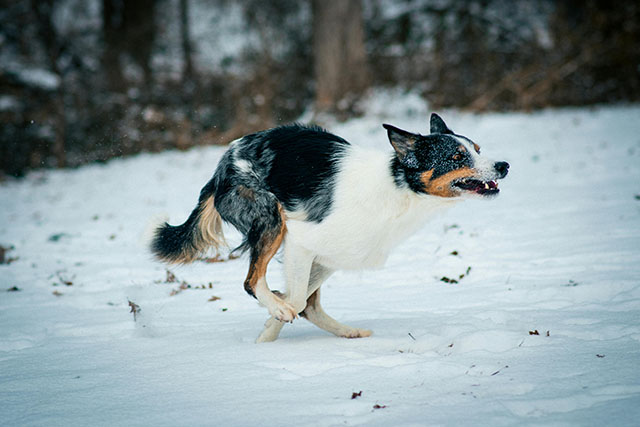Many pet owners have observed their furry friends engaging in a peculiar behavior known as scooting, where dogs drag their bottoms across the floor. This action can seem concerning and perplexing, but it is common among dogs of different breeds.
Understanding the reasons behind dog scooting, including possible causes and associated concerns, and exploring practical home remedies can aid in addressing and easing the discomfort that our beloved canine companions may experience.
Should I Take My Dog to the Vet for Scooting?
While occasional scooting might not be a cause for immediate concern, observing your dog for any recurring or prolonged episodes is essential. These could indicate underlying issues such as impacted anal glands, parasites, or allergies that require professional care. It’s important to pay attention to any changes in your dog’s behavior, like excessive licking or biting at their rear end, as this could signal discomfort.
Additionally, keep an eye out for signs of skin irritation, redness, or foul odors in the affected area. If you notice your dog scooting frequently, exhibiting discomfort around their rear end, or any signs of skin irritation or infection, it’s wise to consult your veterinarian. Early diagnosis and treatment can prevent more serious complications, ensuring your furry friend stays happy and healthy for years to come.
How Do I Get My Dog to Stop Scooting?
Stopping your dog from scooting involves addressing the underlying cause of the discomfort. Here are several home remedies that can help alleviate or prevent scooting:
- Regular Grooming and Bathing: Keeping your dog’s rear clean is essential. Consistent grooming and bathing, along with the application of Vetnique Labs Glandex dog wipes, aids in removing irritants and guarding against infections that may lead to scooting.
- Express Anal Glands Carefully: If the scooting is due to impacted anal glands, gentle expression of these glands can relieve the discomfort. A veterinarian or an experienced groomer best does this to avoid injury.
- Adding Fiber to the Diet: A high-fiber diet like Glandex Dog Fiber Supplement Powder for Anal Glands with Pumpkin can promote the formation of larger stools. This can aid in the natural expression of anal glands during bowel movements, potentially decreasing the necessity for your dog to scoot.
- Ensure Regular Deworming: Since parasites can be a cause of scooting, regular deworming, as recommended by your vet, can help prevent parasitic infections.
- Provide Plenty of Fresh Water: Hydration is key to preventing constipation, another reason dogs might scoot. Make sure your dog has constant access to clean, fresh water.
- Use of Probiotics: Adding probiotics, such as Pet Honesty Probiotics, to your dog’s diet can help maintain a healthy digestive tract and mitigate issues that could lead to scooting.
Remember, while home remedies can be effective for mild cases or as preventive measures, it’s crucial to consult with a veterinarian if the scooting persists to rule out more serious conditions and receive appropriate treatment.
How Can I Help My Dog Express His Glands Naturally?
Assisting your furry companion in naturally expressing his anal glands can play a vital role in maintaining his overall comfort and well-being. It’s a simple process that can be beneficial for your dog’s health.
Incorporating regular exercise into your dog’s daily routine is crucial as it helps stimulate bowel movements, which, in turn, can facilitate the natural expression of the anal glands during defecation. Physical activity promotes a healthy digestive system and ensures your dog’s well-being.
Moreover, ensuring your dog consumes a fiber-rich diet can further support this natural process. A fiber-rich diet can produce healthier and bulkier stools, which apply the necessary pressure on the glands for natural expression. This dietary adjustment can aid in preventing complications related to anal gland issues.
When considering manual expression techniques, it’s important to approach them with caution. Seeking guidance from a professional groomer or veterinarian is highly recommended to prevent discomfort or injury to your beloved pet. Their expertise can ensure that the process is carried out safely and effectively.
If you feel unsure or uncomfortable with performing this task, entrusting it to a professional is always best. Your dog’s safety and health are of utmost importance, and professionals have the knowledge and experience to handle anal gland expression with care and expertise.
What Can I Feed My Dog That Scoots?
Feeding your dog the right kind of diet can be a significant factor in reducing or preventing scooting behavior. Consider incorporating the following into your dog’s diet:
- Pumpkin: High in fiber, pumpkin can help create bulkier stools, aiding in the natural expression of anal glands.
- Wheat Bran: Adding a small amount of wheat bran to your dog’s meals can boost fiber intake and improve bowel movements.
- Cooked Vegetables: Carrots, green beans, and peas are excellent sources of fiber. Ensure they are cooked and chopped small to avoid choking hazards.
- Plain, Cooked Oatmeal: A good source of soluble fiber, oatmeal can help if your dog has softer stools.
- Sweet Potatoes: Another excellent source of fiber, sweet potatoes can help improve your dog’s digestion and reduce scooting.
- Probiotic Supplements: These can help maintain healthy gut flora, improve digestion, and reduce the risk of scooting due to digestive issues.
Any dietary changes should be introduced gradually to avoid upsetting your dog’s stomach, and it’s best to consult with your veterinarian before altering your pet’s diet, especially if you suspect underlying health issues are causing the scooting behavior.
How Long Does Dog Scooting Last?
The duration of dog scooting can vary significantly based on the root cause. When temporary discomforts like minor constipation or irritants trigger the scooting, it typically resolves within a few days through proper care and dietary adjustments. However, if the scooting stems from more persistent issues like impacted anal glands, parasites, or allergies, it may persist until the underlying condition is effectively treated.
Monitoring the situation closely is crucial, and if the scooting persists beyond a few days, seeking advice from a veterinarian is recommended. Early intervention offers quicker relief for your pet and helps prevent more severe health complications.
It’s important to recognize that each dog is unique, and factors such as their overall health and the promptness of addressing the underlying cause can influence their recovery time.
Keeping Your Best Friend Healthy and Happy
Addressing the issue of your dog scooting is crucial not just for their comfort but for their overall health and happiness. Understandably, it might seem like a minor nuisance at first glance, but it’s often a sign that warrants attention. Maintaining regular grooming habits, ensuring a proper diet, and consulting with your veterinarian when issues arise can prevent many of the conditions that lead to scooting.
Our pets rely on us to interpret their behaviors and act in their best interest. Doing so can keep them wagging, happy, and scoot-free.
Jessica is a veterinary medicine student who is passionate about animals. Living with her cherished dog, Milo, deepens her understanding of the human-animal connection, enhancing her empathy as a future veterinarian.
Jessica’s concise articles reflect her dedication to improving the lives of animals and those who care for them, making her an inspiring figure in the pet care field.







